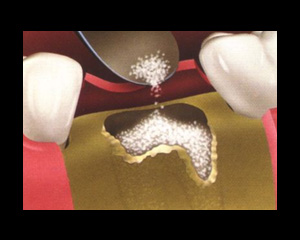Dental Implant Bone Grafting
The success of a dental implant and its ability to support a dental restoration is dependent on the available bone support at the dental implant placement site. Bone volume is affected by factors including periodontal disease, trauma, infections, lenght of time on missing teeth. Many of our patients are deficient in bone and in order for the implant placement to be successful, we have to select a means of regenerating this missing bone. It is a normal practice during the dental implant placement surgical session to open up the site in assessing the actual critical bone support and determining if a conventional, one day or immediate loaded implant might be done or if additional dental bone implant bone graft will be required. 
Why the need for dental implant bone graft
Dental implant bone grafting may be used to:
- fill voids
- create bone volume and repair missing bone
- prevent the loss of bone post tooth extraction
Types of Dental Bone Grafting Technique
There are 3 basic types for dental bone grafts technique:
- Block bone graft : bone grafting using bone harvested and collected bone from own body for bone repairs or additions. In extreme cases, bone may be harvested from areas outside the mouth such as the hip.
- “Bone in a bottle” & Synthetic bone graft : bone grating from cadavers or other sources are often used to stimulate the body’s own bone to grow into the repair site. Such dental bone grafts are very effective and very safe. Synthetic bone graft are also used to stimulate bone formation to accelerate and promote bone formation in graft areas.
- Barrier Membrane Technique: Very often, bone grafting is done with membranes aimed to promote the growth and migration of cells that turn into healthy bone. The membranes are usually removed at a later date, but sometimes they can be resorbed by the body and disappear all on their own.
- Sinus Lift : The human skull has air spaces which are called “sinuses”. Sometimes the sinus are enlarged and intrude on areas where we want to place dental implants. When the upper maxillary sinus prevents the placement of an implant, the side of the sinus is opened and the bottom portion of the sinus raised so it will fill in with bone. Or an “Osteotome Lift” may be done whereby the floor of the sinus right over implant placement site is lifted. Dental implant posts may sometimes be placed either at the same time when sinus lift is done or several months later depending on each individual case.
Type of Dental Bone Graft Materials
- Autogenous Bone : are bone material taken from other areas of the body including adjacent sites, the chin, the tuberosity or the hip.
- Allografts : are bone from genetically unrelated members of the same species that include cadaver bone that are freeze dried.
- Xenografts : are bone from other species. Bio-Oss is a popular brand of xenograft material.
- Barrier Membranes : in addition to the bone grafting materials itself, membranes are often used to guide the generation of new bone. The membrane allows the bone to grow by blocking out the epithelial cells and the connective tissue cells from the site.
For full arch missing teeth, graftless dental implants solutions are now available:
- All-on-4 dental implants
- All-on-6 dental implants
- zygoma implants
